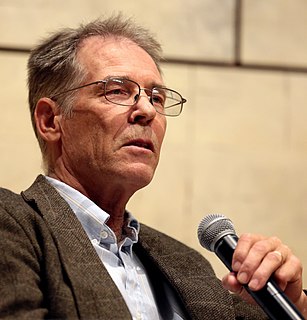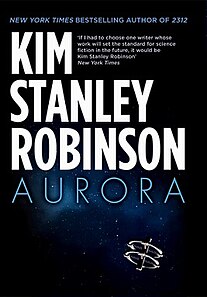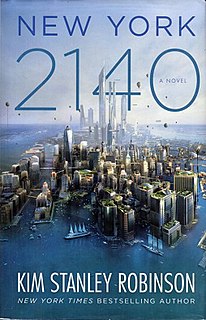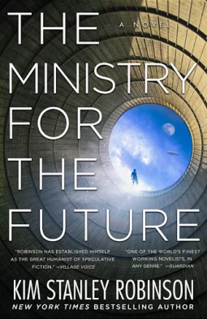
Kim Stanley Robinson is an American writer of science fiction. He has published twenty-two novels and numerous short stories but is best known for his Mars trilogy. His work has been translated into 24 languages. Many of his novels and stories have ecological, cultural, and political themes and feature scientists as heroes. Robinson has won numerous awards, including the Hugo Award for Best Novel, the Nebula Award for Best Novel and the World Fantasy Award. Robinson's work has been labeled by The Atlantic as "the gold-standard of realistic, and highly literary, science-fiction writing." According to an article in The New Yorker, Robinson is "generally acknowledged as one of the greatest living science-fiction writers."

Icehenge is a science fiction novel by American author Kim Stanley Robinson, published in 1984.
The Three Californias Trilogy consists of three books by Kim Stanley Robinson, which depict three different possible futures of Orange County, California. The three books that make up the trilogy are The Wild Shore, The Gold Coast and Pacific Edge. Each of these books describes the life of young people in the three very different near-futures. All three novels begin with an excavation which tells the reader about the world they are entering.

The Years of Rice and Salt is an alternate history novel by American science fiction author Kim Stanley Robinson, published in 2002. The novel explores how world history might have been different if the Black Death plague had killed 99 percent of Europe's population, instead of a third as it did in reality. Divided into ten parts, the story spans hundreds of years, from the army of the Muslim conqueror Timur to the 21st century, with Europe being re-populated by Muslim pioneers, the indigenous peoples of the Americas forming a league to resist Chinese and Muslim invaders, and a 67-year-long world war being fought primarily between Muslim states and the Chinese and their allies. While the ten parts take place in different times and places, they are connected by a group of characters that are reincarnated into each time but are identified to the reader by the first letter of their name being consistent in each life.

Forty Signs of Rain (2004) is the first book in the hard science fiction "Science in the Capital" trilogy by Kim Stanley Robinson. Robinson has been nicknamed the "Master of Disaster" for his description of natural disasters based partly on the contents of this book.

Mundane science fiction (MSF) is a niche literary movement within science fiction that developed in the early 2000s, with principles codified by the "Mundane Manifesto" in 2004, signed by author Geoff Ryman and "The Clarion West 2004 Class". The movement proposes "mundane science fiction" as its own subgenre of science fiction, typically characterized by its setting on Earth or within the Solar System; a lack of interstellar travel, intergalactic travel or human contact with extraterrestrials; and a believable use of technology and science as it exists at the time the story is written or a plausible extension of existing technology. There is debate over the boundaries of MSF and over which works can be considered canonical. Rudy Rucker has noted MSF's similarities to hard science fiction and Ritch Calvin has pointed out MSF's similarities to cyberpunk. Some commentators have identified science fiction films and television series which embody the MSF ethos of near-future realism.

The 68th World Science Fiction Convention (Worldcon), also known as Aussiecon Four, was held on 2–6 September 2010 in the Melbourne Convention and Exhibition Centre in Melbourne, Victoria, Australia.

Galileo's Dream (2009) is a science fiction novel with elements of historical fiction written by author Kim Stanley Robinson. The book itself describes the life of 17th-century scientist and astronomer Galileo Galilei, and the far-future society living on the Galilean moons he discovered. Italicised portions of the text within the novel are actually translations of Galileo and his contemporaries own recorded writings.
Jeremy Robinson, also known as Jeremy Bishop,Jeremiah Knight, and other pen names, is an author of sixty novels and novellas. He is known for mixing elements of science, history, and mythology. Many of his novels have been adapted into comic books, optioned for film and TV, and translated into thirteen languages. He is the author of the Nemesis Saga, the Chess Team series, and the non-fiction title, The Screenplay Workbook.

2312 is a hard science fiction novel by American writer Kim Stanley Robinson, published in 2012. It is set in the year 2312 when society has spread out across the Solar System. The novel won the 2013 Nebula Award for Best Novel.

Climate fiction is literature that deals with climate change and global warming. Not necessarily speculative in nature, works may take place in the world as we know it or in the near future. The genre frequently includes science fiction and dystopian or utopian themes, imagining the potential futures based on how humanity responds to the impacts of climate change. Technologies such as climate engineering or climate adaptation practices often feature prominently in works exploring their impacts on society. Climate fiction is distinct from petrofiction which deals directly with the petroleum culture and economy.

Aurora is a 2015 novel by American science fiction author Kim Stanley Robinson. The novel concerns a generation ship built in the style of a Stanford torus traveling to Tau Ceti in order to begin a human colony. The novel's primary narrating voice is the starship's artificial intelligence. The novel was well-received by critics.
This is a bibliography of American science fiction author Kim Stanley Robinson.
The year 2013 was marked in science fiction by the following events.

Nebula Award Stories Seventeen is an anthology of award winning science fiction short works edited by Joe Haldeman. It was first published in hardcover by Holt, Rinehart and Winston in August 1983; a paperback edition was issued by Ace Books in June 1985 under the variant title Nebula Award Stories 17.

Nebula Awards Showcase 2002 is an anthology of award-winning science fiction short works edited by Kim Stanley Robinson. It was first published in trade paperback by Roc/New American Library in April 2002.

Nebula Awards Showcase 2014 is an anthology of science fiction short works edited by Kij Johnson. It was first published in trade paperback by Pyr in May 2014.

New York 2140 is a 2017 climate fiction novel by American science fiction author Kim Stanley Robinson. The novel is set in a New York City that has been flooded and altered by rising water. The novel received generally positive reviews.

Sol is a solar day on Mars; that is, a Mars-day. A sol is the apparent interval between two successive returns of the Sun to the same meridian as seen by an observer on Mars. It is one of several units for timekeeping on Mars.

The Ministry for the Future is a climate fiction ("cli-fi") novel by American science fiction writer Kim Stanley Robinson published in 2020. Set in the near future, the novel follows a subsidiary body, established under the Paris Agreement, whose mission is to act as an advocate for the world's future generations of citizens as if their rights are as valid as the present generation's. While they pursue various ambitious projects, the effects of climate change are determined to be the most consequential. The plot primarily follows Mary Murphy, the head of the titular Ministry for the Future, and Frank May, an American aid worker traumatized by experiencing a deadly heat wave in India. Many chapters are devoted to other characters' accounts of future events, as well as their ideas about ecology, economics, and other subjects.
















